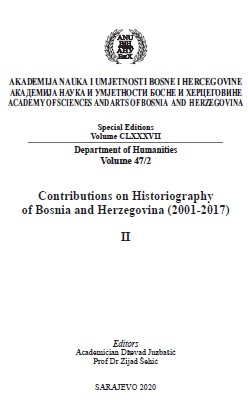Historiografija o Bosni i Hercegovini u bosanskohercegovačkim udžbenicima historije (2000–2017)
Historiography on Bosnia and Herzegovina in history textbooks used in Bosnia and Herzegovina (2000–2017)
Author(s): Melisa Forić Plasto
Subject(s): School education, State/Government and Education, Transformation Period (1990 - 2010), Present Times (2010 - today), Inter-Ethnic Relations, Theory of Literature, Peace and Conflict Studies, Pedagogy
Published by: Akademija Nauka i Umjetnosti Bosne i Hercegovine
Keywords: historiography; textbooks; history teaching; educational policies;
Summary/Abstract: This paper presents an analysis of the history textbooks published and used in Bosnia and Herzegovina in the period 2000–2017 in order to answer how the results of historiographic research on Bosnia and Herzegovina have been incorporated into textbooks content. Considering that the textbook in Bosnia and Herzegovina, as well as in most European countries, continues to serve as a basic teaching tool in history teaching, and in some ways represents a canonized knowledge, an official version of the past that is recommended or better created by national authorities an attempt was made to look at what historiographical reflections on Bosnia and Herzegovina were given in them. The specificity of textbook and educational policy in Bosnia and Herzegovina is reflected in the deep division on the ethnonational principle and the additional fragmentation caused by the administrative organization of Bosnia and Herzegovina after the Dayton Agreement. Instead of a unique historiography on Bosnia and Herzegovina, we come across different approaches in the textbooks. In some of them, information on the past of Bosnia and Herzegovina is rather modest or almost omitted, and emphasis is given to the history of the neighboring countries of Serbia or Croatia or of the Serbian or Croat people. The paper seeks to see what kind of message the past has sent to textbook generations through their education and the role it plays in the future of this country. In examining how the historiography of Bosnia and Herzegovina is contained in the textbooks, based on the analyzed 32 history textbook, we find only a partial answer, which is primarily caused by the different interpretation of national history by the three curricula for which the textbooks were designed. Thus, in Serbian language textbooks, national history is primarily presented as the history of Serbia and Serbs, and partly of Serbs in Bosnia and Herzegovina. Similar is the practice in Croatian textbooks, dominated by the history of Croatia and Croats, while there is very little mention of Croats in Bosnia and Herzegovina. Teaching units related to Bosnia and Herzegovina are represented by 10–20% of the total material and presented with only a few lessons.
Book: Prilozi o historiografiji Bosne i Hercegovine (2001–2017) II
- Page Range: 277-300
- Page Count: 24
- Publication Year: 2020
- Language: Bosnian, Croatian, Serbian
- Content File-PDF

